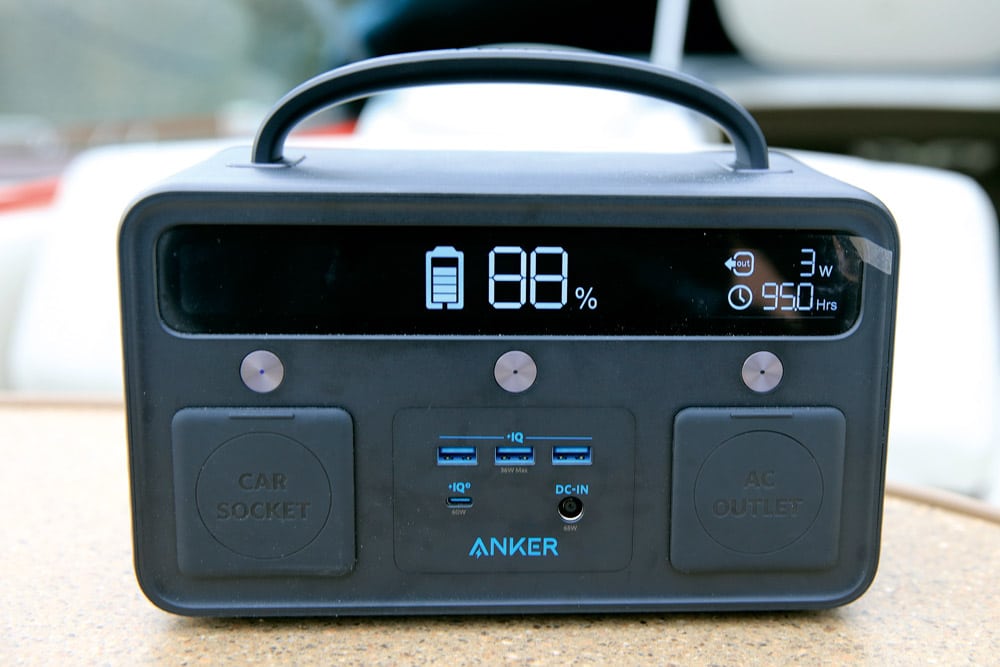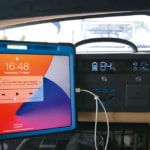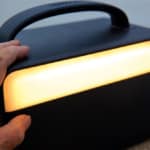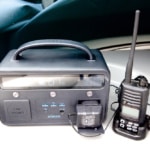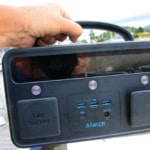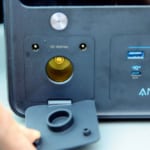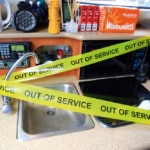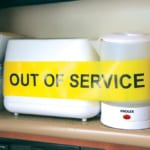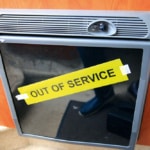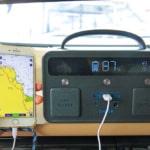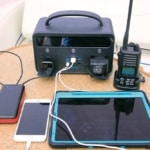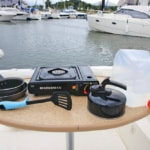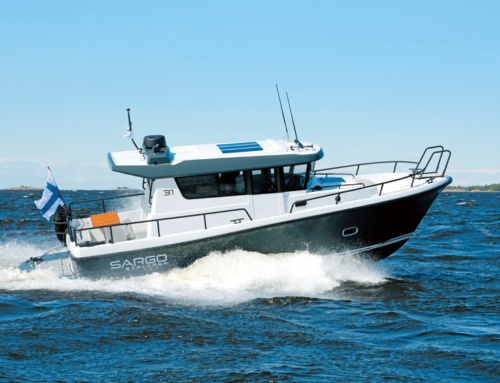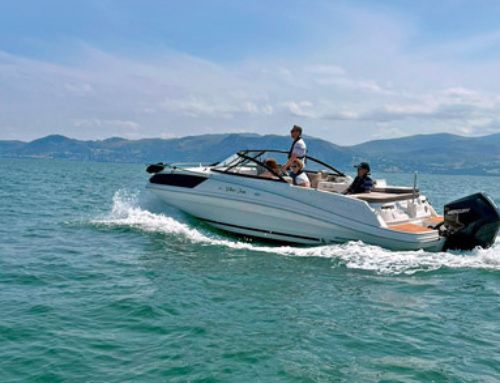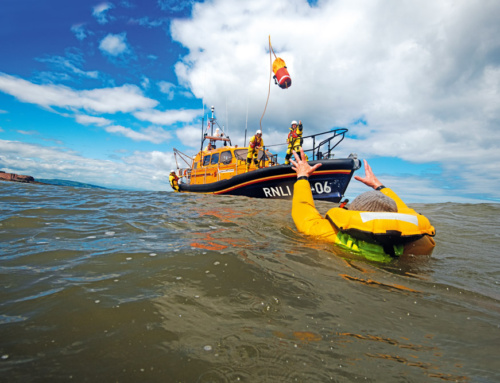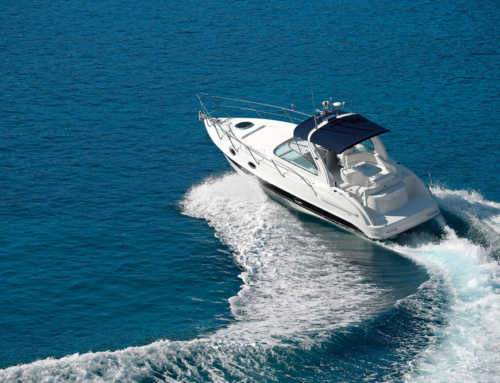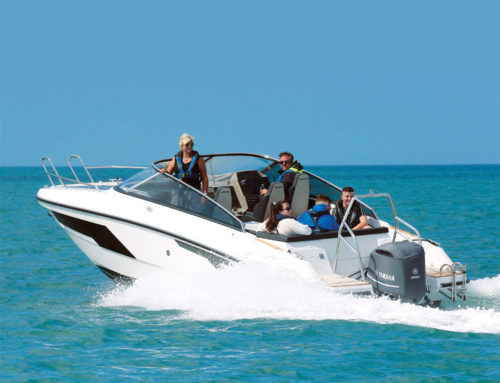Can a portable power bank provide leisure power for a whole weekend? Alex Whittaker trials the Anker 400 and discovers just how effective it is …
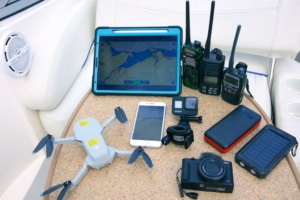
iPad Pro, VHFs, cameras, drone, iPhone and power banks charged by the Anker.
Our boats are continually adapting to the digital age. I don’t just mean digital navigational equipment, I also mean all those high-tech gadgets and leisure items that we wish to carry aboard for a happy weekend on the water. Now, if our vessel is a simple dayboat, finding sufficient on-board outlets to power all our goodies can be difficult. Therefore, I tested a scenario where a dayboat had no power, and yet we needed to power all our modern toys. The solution I chose was a modern portable solid-state power bank.
What is it?
Think of the Anker 400 II as a power generator that requires no petrol. Essentially, it is a portable large-capacity battery bank – in this case about the size of a toaster. It can be charged via the supplied 250VAC mains cable, the also-supplied 12VDC cable or a solar panel, which is not supplied. Because it can also draw the power to be charged from your car or boat’s existing 12V cigar lighter socket, it is a hugely versatile system. I found it very convenient to charge the power bank in my car on the journey from my house to my boat. Also of note is the number of simultaneously usable front-panel outlets. I used these to charge or power all my USB devices. You can also include those newer devices that use the latest high-power USB IQ and USB-C IQ charging standards. The unit also sports two very useful integral lights, a torch and a strip light. The icing on the cake is the built-in front-panel 300W (UK mains style) 250AC outlet socket. This is driven via an integral high-quality true sine wave inverter circuit. This will safely drive or charge sensitive UK mains low-wattage devices like laptops, tablets and TVs.
Capacity
The overall capacity of this particular device is 386W/hr. So theoretically, this model could drive a single 300W device for at least one hour, or a 1W device for at least 300 hours, and anything in between.
- Handy integral torch has three intensity settings plus SOS flasher.
- My iPad Pro fast-charging at 27W via the Type C IQ outlet.
- The larger strip light on the Anker 400 II is very useful. Soft pleasant light.
Metering
The Anker’s state of charge is expressed in nice big numerals. These read in increments of 1%, which is much better than some competing devices that just have five illuminated bars. Most usefully, the unit also shows you instantaneously the amount of wattage being drawn by the particular device you are charging or running. You can easily see which of your devices is consuming the most or least power at the outputs. The screen can also show you how much top-up charge is going into the Anker – very useful when you are topping up the Anker via the 250V mains, your car or boat 12V socket, or indeed an optional solar panel. Furthermore, this clever screen also does the sums for you. If you plug in something to run, say, a TV, a powered cooler box or a carry-aboard fridge, it will tell you how long that item will run for from the Anker’s current state of charge. The screen is well thought out and helps you enormously to manage the power you have stored.
The challenge
OK, let’s get something straight. I am a lazy boater. So this will not be a laboratory figure fest of volts, amps and watt-hours. Rather it is a challenge based on my actual louche boating lifestyle. One Friday I grabbed all the electronic gadgets and gizmos I needed for the weekend and threw them into the back of my car. I then set off for the marina. In this real-world ‘grab ’n’ go challenge’, all my electronic goodies were at whatever state of random charge they happened to be. The idea was to see how far I could get through a normal boating weekend supplying all my ‘leisure’ power needs with just this fully charged Anker 400 II. This meant that my boat’s existing Shore Power 250VAC was out of bounds, as was the boat’s own 12VDC power supply. These deliberate ‘denials of power’ would reduce my hitherto slick ‘all-electric’ Yankee sports cruiser to a simple dayboat, with no on-board power at all. I would find out how much real-world performance could be squeezed out of the Anker’s simple carry-aboard power solution.
- The Anker had no problems with our 250VAC mains charging hand-helds.
- A handy and not too heavy portable power pack
- Highly useful 12VDC cigar lighter output socket: 10A/120W.
Ground rules
The Anker 400 cannot drive high-power heating or cooking devices, or big inductive loads like larger electric motors. It just does not deliver enough wattage, and of course, due to my self-imposed rules, my all-electric boat galley was verboten. So for this experiment, I had to use my existing 10-quid Marksman gas camping stove for all my weekend cooking needs, and especially for boiling water. Besides the ritual fry-ups, I planned to eat simple (non-frozen) dehydrated meals of the kind that campers, hikers and sailors with dayboats might consume. I brought all the drinking water with me too. This was in a £4 plastic cube, complete with tap, bought from the camping shop. This was because I was going ‘the full hair shirt’ and eschewing drawing any power whatsoever from the boat itself. So, no pumped water, no boat microwave, no boat cooking stove – and no boat fridge for the G&Ts. I used a 10-quid cooler box full of ice.
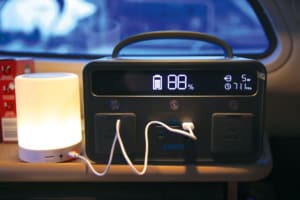
My 10-quid multicoloured light with integral speaker required a 5W charge.
100% charge datum
The Anker was 78% charged when I set off for the marina. En route, I also tried another key feature, namely the Anker’s ability to deliver a charge to another device at the same time as it is being charged from the car. This is called ‘pass through’ charging. Note that some competing units do not have this function. So I connected up my iPad Pro via the Anker’s USB Type C high-output connector and watched it start charging. The charge rate was a nice fat 30W. On arrival at the marina, the Anker was fully charged. So this 100% charge on Friday night was now to be my weekend datum. The plan was to see which leisure items the Anker might power for me aboard the boat before going flat. Incidentally, my iPad Pro on pass through charging had gone from 68% to 100% charge during the journey.
Charge it!
On arrival, I connected my USB-powered hand-held marine VHF and left it on charge. Safety aids come first! However, it was a rainy weekend, so I began listening to music on my iPad Pro and checking my emails, just gently running down its internal battery. I topped up the charge on my iPhone 8 Plus from the Anker later that night. So, if you have seen a suitable weekend weather forecast, grabbed your smartphone, GoPro, VHF radio, tablet, drone and camera and headed for the boat, the Anker can be used to bring them all up to charge. Overall, it is hugely convenient. Just note that its mains inverter output could not drive Mrs Whittaker’s hair dryer or a microwave. This is because items have to stay within the 300W/hr limit. Provided you do this, you are in business.
- The Bayliner 245’s all-electric galley was out of bounds.
- No toaster or electric kettle: mains convenience denied!
- No fridge, so it was ice from the carry-on cooler.
Evening usage
I used the iPad Pro all evening for music and later watched a Netflix movie streamed via the marina Wi-Fi. This all took the charge down to 88%. I also kept my iPhone 8 Plus smartphone topped up.
High-powered USB outlets
As already hinted at, USB power has become the modern standard for all sorts of modern leisure items. It is worth bearing in mind that the USB ‘standard’ actually now comes in a number of new flavours. It has come a long way from its humble 5V @ 1.2A beginnings. These days some of the newer high-power USB standards can deliver much higher voltages and currents. Some can also ‘handshake’ between the charger and the battery to maximise new fast-charging protocols. For instance, my USB-C socketed iPad Pro will fast-charge in under an hour with the correct C lead and charger. So will many modern smartphones. Such modern USB IQ and USB-C outlets are really worth having on a power bank. The Anker front panel sports two normal USB sockets, plus one high-power IQ 36W standard socket, and an IQ USB-C-type 60W socket. The latter is a great boon for fast-charging if your device matches this standard. Be mindful that not all power banks share the Anker’s versatility in this regard.
The verdict
Well, I got through to Sunday evening without running out of power. The Anker 400 II retained a 22% charge, which I thought was impressive. This means that, with careful power management, the system would work continuously over longer coastal cruises as ‘carry-aboard’ power. Your boat engine’s 12V output would be needed to top up the Anker’s ‘overnight use’ every day as you cruised. In this way, you could certainly meet your daily iPad navigational needs and maintain iPhone communications, as well as safely charging your hand-held marine band VHF. Well worth a thought!
- Keeping your backup nav device fully charged is easy with the Anker 400 II.
- Louche versatility: simultaneous multi-item charging via the Anker 400 II.
- The Anker will not cook your food, so I reverted to canned gas.
Price and availability
I bought this item with my own money, paying £299 from Amazon UK. It was delivered next day from Anker.

